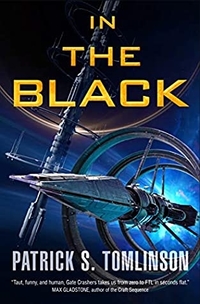Revenger by Alastair Reynolds
 Saturday, December 5, 2020 at 9:25PM
Saturday, December 5, 2020 at 9:25PM 
Published by Orbit/ Victor Gollancz Ltd on January 1, 2016
Revenger is a space opera with some unexplained elements that border on fantasy. It’s a good story for young adults. I didn’t know it was YA fiction when I started it but the story held my interest so I stayed with it. The third novel in the series came out this year, which is why I decided to read the first one. I doubt that I’ll read the next two because, like most YA fiction, the novel explores themes that appeal to young adults. I'm not young. Revenger lacks the complexity that appeals to more mature readers.I was also bothered by story’s failure to explain so much of the universe in which it exists. That’s common in fantasy and in YA fiction but adult science fiction fans demand to know why things are the way they are.
The story takes place in a future characterized by at least a dozen epochs that historians characterized as Occupations. There was a major war between the Second and Third Occupation, perhaps a war between aliens. A good bit of knowledge and technology from the past has been lost. Many worlds were settled during the Occupations. Some of them are artificial habitats. They are collectively known as the Congregation. Various editions of the Book of Worlds have cataloged them but books are in short supply when Revenger begins.
Laced among the habitats are worlds called Baubles. The Baubles are only accessible at certain times; they “open” for certain periods. Scavengers can find all kinds of treasure from past Occupations behind locked doors inside Baubles, but they need to get in and out before the Bauble closes or they’ll be stuck there, fated to die when their oxygen is depleted.
To find and exploit Baubles, scavengers need a specialized crew. One member needs to read the signs to predict when a Bauble will open. Another needs to open the doors they find in the Bauble. An assessor decides what’s valuable. Then there’s a captain and pilot and someone who deploys the sunsails. The most difficult position to fill is that of Sympathetic, also known as a bone reader. The bone reader plugs headphones into a skull and is able to communicate with other ships. Most people can’t read the skulls and those who can lose the ability as they enter their twenties. The skulls are ancient technology and are getting difficult to find.
Against that background, two teenage sisters are given the opportunity to become bone readers. Adrana and Arafura Ness are looking for adventure. They seem to find it on Captain Rackamore’s ship. When they encounter a future version of a pirate, a legendary and seemingly long-lived woman named Bosa Sennen, the girls become separated. Fura spends the rest of the novel trying to get back onto a ship and to find Adrana. But both girls change over the course of the novel; by the end, neither is what the other expects her to be.
The background is interesting and, to the extent that it isn’t always well explained, perhaps there’s no reason it should be. Fura narrates the story and she has no way to explain things she doesn’t understand, like why Baubles exist or how they operate, or why communications devices are made from skulls, or what “ghosty” technology is all about. On the other hand, I suspect that Alastair Reynolds didn’t bother to invent explanations because he knew that a young audience wouldn’t demand them.
The simple themes of good versus evil, sisters separated but still devoted to each other, and young people who are eager to leave home and make their own lives will appear to a YA audience. I think Alastair Reynolds is a much better writer when he markets his fiction to adults, but I’m recommending Revenger to the YA audience for which it is intended.
RECOMMENDED



